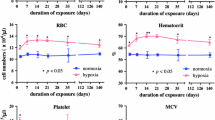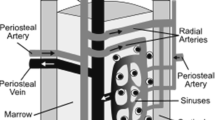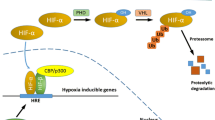Abstract
Thyroid hormone stimulates erythropoietic differentiation. However, severe anemia is sometimes seen in patients with hyperthyroidism, and the mechanisms have not been fully elucidated. Bone marrow is comprised about 2–8 % oxygen, and the characteristics of hematopoietic stem cells have been shown to be influenced under hypoxia. Hypoxia-inducible factor-1 is a critical mediator of cellular responses to hypoxia and an important mediator in signal transduction of thyroid hormone [triiodothyronine (T3)]. The aim of this study was to investigate the effect of T3 on erythropoiesis under hypoxia mimicking physiological conditions in the bone marrow. We maintained human erythroleukemia K562 cells under hypoxic atmosphere (2 % O2) and examined their cellular characteristics. Compared to that under normal atmospheric conditions, cells under hypoxia showed a reduction in the proliferation rate and increase in the hemoglobin content or benzidine-positive rate, indicating promotion of erythroid differentiation. T3 had no effect on hypoxia-induced erythroid differentiation, but significantly inhibited activin A/erythroid differentiation factor-induced erythroid differentiation. Moreover, GATA2 mRNA expression was suppressed in association with erythroid differentiation, while T3 significantly diminished that suppression. These results suggest that T3 has a direct suppressive effect on erythroid differentiation under hypoxic conditions.



Similar content being viewed by others
References
Das KC, Mukherjee M, Sarkar TK, Dash RJ, Rastogi GK (1975) Erythropoiesis and erythropoietin in hypo- and hyperthyroidism. J Clin Endocrinol Metab 40:211–220
Fein HG, Rivlin RS (1975) Anemia in thyroid diseases. Med Clin North Am 59:1133–1145
Golde DW, Bersch N, Chopra IJ, Cline MJ (1977) Thyroid hormones stimulate erythropoiesis in vitro. Br J Haematol 37:173–177
Malgor LA, Blanc CC, Klainer E, Irizar SE, Torales PR, Barrios L (1975) Direct effects of thyroid hormones on bone marrow erythroid cells of rats. Blood 45:671–679
Perrin MC, Blanchet JP, Mouchiroud G (1997) Modulation of human and mouse erythropoiesis by thyroid hormone and retinoic acid: evidence for specific effects at different steps of the erythroid pathway. Hematol Cell Ther 39:19–26
Bauer A, Mikulits W, Lagger G, Stengl G, Brosch G, Beug H (1998) The thyroid hormone receptor functions as a ligand-operated developmental switch between proliferation and differentiation of erythroid progenitors. EMBO J 17:4291–4303
Gianoukakis AG, Leigh MJ, Richards P, Christenson PD, Hakimian A, Fu P, Niihara Y, Smith TJ (2009) Characterization of the anaemia associated with Graves’ disease. Clin Endocrinol (Oxf) 70:781–787
Jing D, Wobus M, Poitz DM, Bornhauser M, Ehninger G, Ordemann R (2012) Oxygen tension plays a critical role in the hematopoietic microenvironment in vitro. Haematologica 97:331–339
Takubo K, Suda T (2012) Roles of the hypoxia response system in hematopoietic and leukemic stem cells. Int J Hematol 95:478–483
Nakayama K (2009) Cellular signal transduction of the hypoxia response. J Biochem 146:757–765
Simon MC, Keith B (2008) The role of oxygen availability in embryonic development and stem cell function. Nat Rev Mol Cell Biol 9:285–296
Majmundar AJ, Wong WJ, Simon MC (2010) Hypoxia-inducible factors and the response to hypoxic stress. Mol Cell 40:294–309
Rogers HM, Yu X, Wen J, Smith R, Fibach E, Noguchi CT (2008) Hypoxia alters progression of the erythroid program. Exp Hematol 36:17–27
Nikolsky I, Serebrovska TV (2009) Role of hypoxia in stem cell development and functioning. Fiziol Zh 55:116–130
Parmar K, Mauch P, Vergilio JA, Sackstein R, Down JD (2007) Distribution of hematopoietic stem cells in the bone marrow according to regional hypoxia. Proc Natl Acad Sci USA 104:5431–5436
Otto T, Fandrey J (2008) Thyroid hormone induces hypoxia-inducible factor 1alpha gene expression through thyroid hormone receptor beta/retinoid X receptor alpha-dependent activation of hepatic leukemia factor. Endocrinology 149:2241–2250
Moeller LC, Dumitrescu AM, Walker RL, Meltzer PS, Refetoff S (2005) Thyroid hormone responsive genes in cultured human fibroblasts. J Clin Endocrinol Metab 90:936–943
Moeller LC, Broecker-Preuss M (2011) Transcriptional regulation by nonclassical action of thyroid hormone. Thyroid Res 4(Suppl 1):S6
Hoffman R, Murnane MJ, Benz EJ Jr, Prohaska R, Floyd V, Dainiak N, Forget BG, Furthmayr H (1979) Induction of erythropoietic colonies in a human chronic myelogenous leukemia cell line. Blood 54:1182–1187
Horton MA, Cedar SH, Edwards PA (1981) Expression of red cell specific determinants during differentiation in the K562 erythroleukaemia cell line. Scand J Haematol 27:231–240
Broxmeyer HE, Lu L, Cooper S, Schwall RH, Mason AJ, Nikolics K (1988) Selective and indirect modulation of human multipotential and erythroid hematopoietic progenitor cell proliferation by recombinant human activin and inhibin. Proc Natl Acad Sci USA 85:9052–9056
Shiozaki M, Sakai R, Tabuchi M, Nakamura T, Sugino K, Sugino H, Eto Y (1992) Evidence for the participation of endogenous activin A/erythroid differentiation factor in the regulation of erythropoiesis. Proc Natl Acad Sci USA 89:1553–1556
Rowley PT, Ohlsson-Wilhelm BM, Farley BA, LaBella S (1981) Inducers of erythroid differentiation in K562 human leukemia cells. Exp Hematol 9:32–37
Lozzio CB, Lozzio BB (1975) Human chronic myelogenous leukemia cell-line with positive Philadelphia chromosome. Blood 45:321–334
Tonkonow BL, Hoffman R, Burger D, Elder JT, Mazur EM, Murnane MJ, Benz EJ Jr (1982) Differing responses of globin and glycophorin gene expression to hemin in the human leukemia cell line K562. Blood 59:738–746
Zhang FL, Shen GM, Liu XL, Wang F, Zhao YZ, Zhang JW (2012) Hypoxia-inducible factor 1-mediated human GATA1 induction promotes erythroid differentiation under hypoxic conditions. J Cell Mol Med 16:1889–1899
Jin W, Li Q, Wang J, Chang G, Lin Y, Li H, Wang L, Gao W, Pang T (2012) Na+/H+ exchanger 1 inhibition contributes to K562 leukaemic cell differentiation. Cell Biol Int 36:739–745
Sarakul O, Vattanaviboon P, Tanaka Y, Fucharoen S, Abe Y, Svasti S, Umemura T (2013) Enhanced erythroid cell differentiation in hypoxic condition is in part contributed by miR-210. Blood Cells Mol Dis 51:98–103
Kaneko H, Shimizu R, Yamamoto M (2010) GATA factor switching during erythroid differentiation. Curr Opin Hematol 17:163–168
Andrews NC (1998) The NF-E2 transcription factor. Int J Biochem Cell Biol 30:429–432
Cheng SY, Leonard JL, Davis PJ (2010) Molecular aspects of thyroid hormone actions. Endocr Rev 31:139–170
Marsee DK, Pinkus GS, Yu H (2010) CD71 (transferrin receptor): an effective marker for erythroid precursors in bone marrow biopsy specimens. Am J Clin Pathol 134:429–435
Dong HY, Wilkes S, Yang H (2011) CD71 is selectively and ubiquitously expressed at high levels in erythroid precursors of all maturation stages: a comparative immunochemical study with glycophorin A and hemoglobin A. Am J Surg Pathol 35:723–732
Bresnick EH, Lee HY, Fujiwara T, Johnson KD, Keles S (2010) GATA switches as developmental drivers. J Biol Chem 285:31087–31093
Matsushita A, Sasaki S, Kashiwabara Y, Nagayama K, Ohba K, Iwaki H, Misawa H, Ishizuka K, Nakamura H (2007) Essential role of GATA2 in the negative regulation of thyrotropin beta gene by thyroid hormone and its receptors. Mol Endocrinol 21:865–884
Acknowledgments
We thank Ms. Maki Uenoyama (Division of Environmental Medicine, National Defense Medical College Research Institute, National Defense Medical College) for her help with the experimental procedures. This work was supported in part by the joint research program of the Institute for Molecular and Cellular Regulation, Gunma University, Japan.
Conflict of interest
The authors report no conflicts of interest.
Author information
Authors and Affiliations
Corresponding author
Rights and permissions
About this article
Cite this article
Yamamoto, Y., Shiraishi, M., Fujita, M. et al. Triiodothyronine suppresses activin-induced differentiation of erythroleukemia K562 cells under hypoxic conditions. Mol Cell Biochem 391, 217–224 (2014). https://doi.org/10.1007/s11010-014-2005-7
Received:
Accepted:
Published:
Issue Date:
DOI: https://doi.org/10.1007/s11010-014-2005-7




